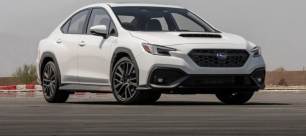In driving the first Subaru Impreza WRX when it launched here in the early 1990s, the first attempt to control its surging, decidedly non-linear acceleration felt like pulling back on the reins of a bolting horse.
Subaru was in the thick of its commitment to the World Rally Championship (WRX stands for ‘World Rally eXperimental’) and the Japanese maker had a red hot product on its hands.
Fast forward to the 2024 version and the turbo torque still arrives with something of a rush but this is an infinitely more refined performance sedan than its relatively raw ancestor.
Subaru doesn’t quote a 0-100km/h figure but expect it to come up in the high five-second bracket and with maximum torque available all the way from 2000–5200rpm (and peak power taking over at 5600rpm) there’s always plenty or urgent acceleration available.
And that pulsing engine noise and percussive exhaust beat is still there in a no less distinctive and entertaining way. Our test car was fitted with the newly optional STi-branded exhaust ($2497, fitted) which adds to the aural impact.
The gearshift isn’t ‘click-clack’ direct but it’s smooth and positive and the clutch is perfectly weighted. Such a pleasure to swap through the ratios, with a bit of old school heel and toe action thrown in for downshifts. Love it.
Subaru says the ‘Global Platform’ underpinning the WRX features a “full inner-frame construction” making it “14 per cent better in terms of front lateral flexing rigidity and 28 per cent stiffer torsionally” than its predecessor.
Suspension is strut front, double wishbone rear, which is a relatively sophisticated configuration allowing the WRX RS to combine impressive ride quality with excellent dynamic response.
The 245/40 Dunlop SP Sport Maxx rubber grips hard and steadfastly refuses to squeal or squirm in ‘press-on’ cornering, the AWD system defaulting to a nominal 45/55 front/rear torque split to deliver an initial rear-drive attitude with active torque vectoring helping to keep any pesky understeer in check.
Push even harder and the system seamlessly adjusts the balance. And to top it off, the steering is great; accurate with good road feel.
Despite an alloy bonnet and front guards (even the fuel flap is resin) the WRX RS weighs in at 1482kg. That’s solid without qualifying as chonky, and it still feels nimble, responsive and balanced, helped in no small part by the boxer engine lowering the car’s overall centre of gravity.
The WRX has copped some criticism in the past about its braking performance under intense pressure. And while we didn’t hammer the RS around a race circuit we did repeatedly apply full-force to the centre pedal without any noticeable reduction in effectiveness.
For the record, the system uses ventilated discs all around (290mm fr / 316mm rr) with dual-piston front calipers up front and singles at the rear. In everyday use the pedal is agreeably progressive.
Under the heading of general, mainly ergonomic, observations, the driver display may not be full digital but the 4.2-inch multi-information display in the centre of the instrument cluster delivers a healthy amount of relevant information clearly and simply.
At 11.2 metres the turning circle is okay, while vision for parking, supported by a high-def reversing camera is good. And applying the manual park brake is another reminder of the physical nature of this car.






